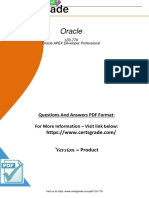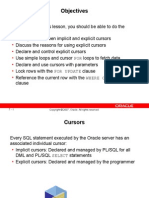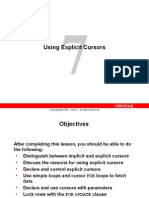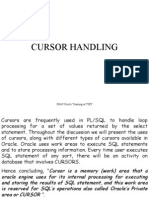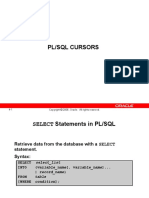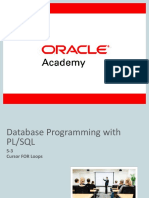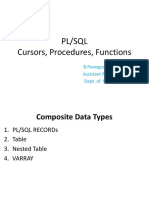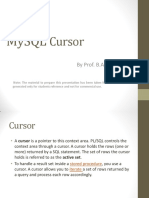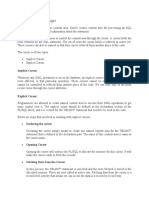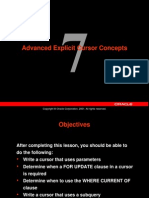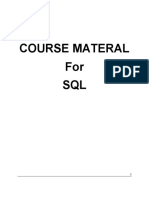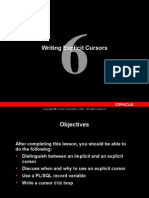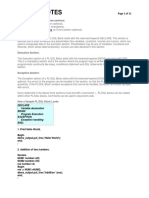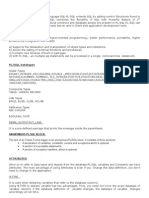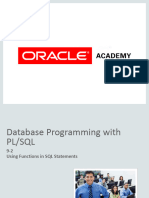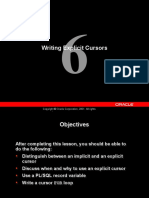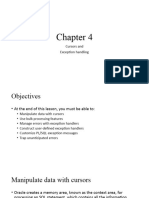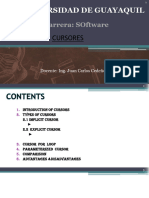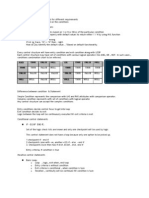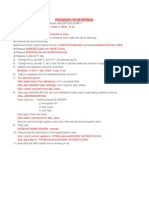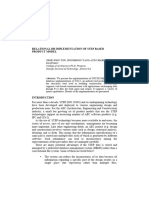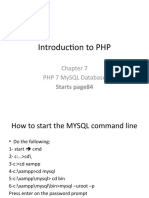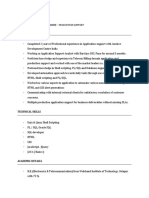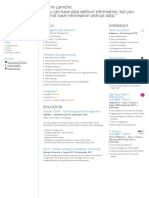0 ratings0% found this document useful (0 votes)
12 viewsLes06 12787960143317 Phpapp02
Les06 12787960143317 Phpapp02
Uploaded by
Mário AraújoAfter completing this lesson, you should be able to do the following: Distinguish between an implicit and an explicit cursor use a PL / SQL record variable Write a cursor for loop 6-3 Copyright (c) Oracle Corporation, 2001. All rights reserved. Every SQL statement executed by the Oracle Server has an individual cursor associated with it.
Copyright:
© All Rights Reserved
Available Formats
Download as PPT, PDF, TXT or read online from Scribd
Les06 12787960143317 Phpapp02
Les06 12787960143317 Phpapp02
Uploaded by
Mário Araújo0 ratings0% found this document useful (0 votes)
12 views25 pagesAfter completing this lesson, you should be able to do the following: Distinguish between an implicit and an explicit cursor use a PL / SQL record variable Write a cursor for loop 6-3 Copyright (c) Oracle Corporation, 2001. All rights reserved. Every SQL statement executed by the Oracle Server has an individual cursor associated with it.
Original Title
les06-12787960143317-phpapp02
Copyright
© © All Rights Reserved
Available Formats
PPT, PDF, TXT or read online from Scribd
Share this document
Did you find this document useful?
Is this content inappropriate?
After completing this lesson, you should be able to do the following: Distinguish between an implicit and an explicit cursor use a PL / SQL record variable Write a cursor for loop 6-3 Copyright (c) Oracle Corporation, 2001. All rights reserved. Every SQL statement executed by the Oracle Server has an individual cursor associated with it.
Copyright:
© All Rights Reserved
Available Formats
Download as PPT, PDF, TXT or read online from Scribd
Download as ppt, pdf, or txt
0 ratings0% found this document useful (0 votes)
12 views25 pagesLes06 12787960143317 Phpapp02
Les06 12787960143317 Phpapp02
Uploaded by
Mário AraújoAfter completing this lesson, you should be able to do the following: Distinguish between an implicit and an explicit cursor use a PL / SQL record variable Write a cursor for loop 6-3 Copyright (c) Oracle Corporation, 2001. All rights reserved. Every SQL statement executed by the Oracle Server has an individual cursor associated with it.
Copyright:
© All Rights Reserved
Available Formats
Download as PPT, PDF, TXT or read online from Scribd
Download as ppt, pdf, or txt
You are on page 1of 25
Copyright Oracle Corporation, 2001. All rights reserved.
Writing Explicit Cursors
6-2 Copyright Oracle Corporation, 2001. All rights reserved.
Objectives
After completing this lesson, you should be able to
do the following:
Distinguish between an implicit and an explicit
cursor
Discuss when and why to use an explicit cursor
Use a PL/SQL record variable
Write a cursor FOR loop
6-3 Copyright Oracle Corporation, 2001. All rights reserved.
About Cursors
Every SQL statement executed by the Oracle Server
has an individual cursor associated with it:
Implicit cursors: Declared for all DML and PL/SQL
SELECT statements
Explicit cursors: Declared and named by the
programmer
6-4 Copyright Oracle Corporation, 2001. All rights reserved.
Explicit Cursor Functions
6-5 Copyright Oracle Corporation, 2001. All rights reserved.
Controlling Explicit Cursors
6-6 Copyright Oracle Corporation, 2001. All rights reserved.
Controlling Explicit Cursors
1. Open the cursor
2. Fetch a row
3. Close the Cursor
6-7 Copyright Oracle Corporation, 2001. All rights reserved.
Controlling Explicit Cursors
1. Open the cursor
2. Fetch a row
3. Close the Cursor
6-8 Copyright Oracle Corporation, 2001. All rights reserved.
Controlling Explicit Cursors
1. Open the cursor
2. Fetch a row
3. Close the Cursor
6-9 Copyright Oracle Corporation, 2001. All rights reserved.
Declaring the Cursor
Do not include the INTO clause in the cursor
declaration.
If processing rows in a specific sequence is
required, use the ORDER BY clause in the query.
CURSOR cursor_name IS
select_statement;
Syntax:
6-10 Copyright Oracle Corporation, 2001. All rights reserved.
Declaring the Cursor
DECLARE
CURSOR emp_cursor IS
SELECT employee_id, last_name
FROM employees;
CURSOR dept_cursor IS
SELECT *
FROM departments
WHERE location_id = 170;
BEGIN
...
Example:
6-11 Copyright Oracle Corporation, 2001. All rights reserved.
Opening the Cursor
Syntax:
OPEN cursor_name;
Open the cursor to execute the query and identify
the active set.
If the query returns no rows, no exception is
raised.
Use cursor attributes to test the outcome after a
fetch.
6-12 Copyright Oracle Corporation, 2001. All rights reserved.
Fetching Data from the Cursor
Syntax:
FETCH cursor_name INTO [variable1, variable2, ...]
| record_name];
Retrieve the current row values into variables.
Include the same number of variables.
Match each variable to correspond to the columns
positionally.
Test to see whether the cursor contains rows.
6-13 Copyright Oracle Corporation, 2001. All rights reserved.
Fetching Data from the Cursor
Example:
LOOP
FETCH emp_cursor INTO v_empno,v_ename;
EXIT WHEN ...;
...
-- Process the retrieved data
END LOOP;
6-14 Copyright Oracle Corporation, 2001. All rights reserved.
Closing the Cursor
Syntax:
CLOSE cursor_name;
Close the cursor after completing the processing
of the rows.
Reopen the cursor, if required.
Do not attempt to fetch data from a cursor after it
has been closed.
6-15 Copyright Oracle Corporation, 2001. All rights reserved.
Explicit Cursor Attributes
Obtain status information about a cursor.
6-16 Copyright Oracle Corporation, 2001. All rights reserved.
The %ISOPEN Attribute
Fetch rows only when the cursor is open.
Use the %ISOPEN cursor attribute before
performing a fetch to test whether the cursor is
open.
Example:
IF NOT emp_cursor%ISOPEN THEN
OPEN emp_cursor;
END IF;
LOOP
FETCH emp_cursor ...
6-17 Copyright Oracle Corporation, 2001. All rights reserved.
Controlling Multiple Fetches
Process several rows from an explicit cursor using
a loop.
Fetch a row with each iteration.
Use explicit cursor attributes to test the success
of each fetch.
6-18 Copyright Oracle Corporation, 2001. All rights reserved.
The %NOTFOUND
and %ROWCOUNT Attributes
Use the %ROWCOUNT cursor attribute to retrieve an
exact number of rows.
Use the %NOTFOUND cursor attribute to determine
when to exit the loop.
6-19 Copyright Oracle Corporation, 2001. All rights reserved.
Example
SET SERVEROUTPUT ON
DECLARE
v_empno employees.employee_id%TYPE;
v_ename employees.last_name%TYPE;
CURSOR emp_cursor IS
SELECT employee_id, last_name FROM employees;
BEGIN
OPEN emp_cursor;
LOOP
FETCH emp_cursor INTO v_empno, v_ename;
EXIT WHEN emp_cursor%ROWCOUNT > 10 OR
emp_cursor%NOTFOUND;
DBMS_OUTPUT.PUT_LINE (TO_CHAR(v_empno)
||' '|| v_ename);
END LOOP;
CLOSE emp_cursor;
END ;
6-20 Copyright Oracle Corporation, 2001. All rights reserved.
Cursors and Records
CREATE TABLE temp_list AS SELECT employee_id, last_name
FROM employees WHERE employee_id = 50;
DECLARE
CURSOR emp_cursor IS SELECT employee_id, last_name FROM employees;
emp_record emp_cursor%ROWTYPE;
BEGIN
OPEN emp_cursor;
LOOP
FETCH emp_cursor INTO emp_record;
EXIT WHEN emp_cursor%NOTFOUND;
INSERT INTO temp_list (empid, empname)
VALUES (emp_record.employee_id, emp_record.last_name);
END LOOP;
COMMIT;
CLOSE emp_cursor;
END;
Process the rows of the active set by fetching values into a PL/SQL RECORD.
6-21 Copyright Oracle Corporation, 2001. All rights reserved.
Cursor FOR Loops
FOR record_name IN cursor_name LOOP
statement1;
statement2;
. . .
END LOOP;
Syntax:
The cursor FOR loop is a shortcut to process
explicit cursors.
Implicit open, fetch, exit, and close occur.
The record is implicitly declared.
6-22 Copyright Oracle Corporation, 2001. All rights reserved.
Cursor FOR Loops
SET SERVEROUTPUT ON
DECLARE
CURSOR emp_cursor IS SELECT last_name, department_id
FROM employees;
BEGIN
FOR emp_record IN emp_cursor LOOP
--implicit open and implicit fetch occur
IF emp_record.department_id = 80 THEN
DBMS_OUTPUT.PUT_LINE (Employee ||
emp_record.last_name || works in the Sales Dept. );
END IF;
END LOOP; --implicit close and implicit loop exit
END ;
Print a list of the employees who work for the sales department.
6-23 Copyright Oracle Corporation, 2001. All rights reserved.
Cursor FOR Loops Using Subqueries
SET SERVEROUTPUT ON
BEGIN
FOR emp_record IN (SELECT last_name, department_id FROM employees) LOOP
--implicit open and implicit fetch occur
IF emp_record.department_id = 80 THEN
DBMS_OUTPUT.PUT_LINE (Employee || emp_record.last_name
|| works in the Sales Dept. );
END IF;
END LOOP; --implicit close occurs
END ;
No need to declare the cursor.
Example:
6-24 Copyright Oracle Corporation, 2001. All rights reserved.
Summary
In this lesson you should have learned to:
Distinguish cursor types:
Implicit cursors: used for all DML statements and
single-row queries
Explicit cursors: used for queries of zero, one, or
more rows
Manipulate explicit cursors
Evaluate the cursor status by using cursor attributes
Use cursor FOR loops
6-25 Copyright Oracle Corporation, 2001. All rights reserved.
Practice 6 Overview
This practice covers the following topics:
Declaring and using explicit cursors to query rows
of a table
Using a cursor FOR loop
Applying cursor attributes to test the cursor status
You might also like
- Exam 1Z0 770 PDF Dumps 2023Document5 pagesExam 1Z0 770 PDF Dumps 2023Garrison hales0% (1)
- Oracle Advanced PL/SQL Developer Professional GuideFrom EverandOracle Advanced PL/SQL Developer Professional GuideRating: 4 out of 5 stars4/5 (8)
- Quiz 1-3 TigerDocument68 pagesQuiz 1-3 TigerRio ArdayanaNo ratings yet
- 5-Using Explicit CursorsDocument24 pages5-Using Explicit CursorsasifsubhanNo ratings yet
- D80182GC10 Les08Document28 pagesD80182GC10 Les08Issa SambNo ratings yet
- Les 07Document34 pagesLes 07alaasamakNo ratings yet
- Cursor Handling: Sbop Oracle Training at TietDocument60 pagesCursor Handling: Sbop Oracle Training at Tieteumine100% (3)
- PL SQL Les04 CursorsDocument48 pagesPL SQL Les04 Cursorsمحمد المقريNo ratings yet
- Module 5 PLSQL - 5 - 3Document20 pagesModule 5 PLSQL - 5 - 3Christian Jay CusayNo ratings yet
- PLSQL - Cursor Online Session Notes PDFDocument35 pagesPLSQL - Cursor Online Session Notes PDFsarala deviNo ratings yet
- Sem1 FinalDocument497 pagesSem1 FinalNox MidNo ratings yet
- Zeba Cursors1Document5 pagesZeba Cursors1nagarajuvcc123No ratings yet
- CCS0029 Les8 Part4 PDFDocument16 pagesCCS0029 Les8 Part4 PDFWilliam RomanoNo ratings yet
- Mysql 6Document29 pagesMysql 6vaibhavbdxNo ratings yet
- PLSQLDocument43 pagesPLSQLvigneshwaranmNo ratings yet
- CursorDocument39 pagesCursorDeepak MalusareNo ratings yet
- PL SQL MaterialDocument31 pagesPL SQL Materialwritesmd100% (4)
- PLSQL 5 1Document35 pagesPLSQL 5 1ssmileNo ratings yet
- PLSQLDocument17 pagesPLSQLinianeceNo ratings yet
- Unit-4 Database CursorsDocument11 pagesUnit-4 Database CursorsdemodgdgNo ratings yet
- What Is CURSOR in PLDocument5 pagesWhat Is CURSOR in PLAshok Kumar KumaresanNo ratings yet
- CURSOR Handling in PLSQLDocument21 pagesCURSOR Handling in PLSQLmsinghbe21No ratings yet
- Advanced PLSQL - UpdatedDocument81 pagesAdvanced PLSQL - UpdatedredroNo ratings yet
- Cursors Jai Maa DurgaDocument13 pagesCursors Jai Maa DurgapapusahaNo ratings yet
- PL SQLDocument41 pagesPL SQLmeetravi007No ratings yet
- Advanced Explicit Cursor ConceptsDocument14 pagesAdvanced Explicit Cursor ConceptsMário AraújoNo ratings yet
- Chapter 04Document10 pagesChapter 04Juan TelloNo ratings yet
- CursorDocument6 pagesCursorRitoliyaNo ratings yet
- Designing PL/SQL CodeDocument32 pagesDesigning PL/SQL CodeJhon R Quintero HNo ratings yet
- 12 Tics Practices Interacting With Databases Key 1Document3 pages12 Tics Practices Interacting With Databases Key 1Akansha SaxenaNo ratings yet
- Oracle 10g Cursor ConceptsDocument11 pagesOracle 10g Cursor ConceptsSelvaraj V100% (1)
- Cursors LectureDocument30 pagesCursors LectureMuhammad Bilal AyubNo ratings yet
- PLSQL_5_4_sgDocument19 pagesPLSQL_5_4_sgvaadharshvishal10aNo ratings yet
- Database Systems: Lab 08 PL SQL (Continue)Document30 pagesDatabase Systems: Lab 08 PL SQL (Continue)NehaNo ratings yet
- PL-SQL - Part2: Exception Handling Procedure Function Cursors TriggerDocument80 pagesPL-SQL - Part2: Exception Handling Procedure Function Cursors TriggerKARTIKAY LADDHANo ratings yet
- PLSQL & Relational AlgebraDocument21 pagesPLSQL & Relational AlgebraSwathi GR Swathi GRNo ratings yet
- SQL MaterialDocument137 pagesSQL MaterialPratap BilluNo ratings yet
- PLSQL Les06Document30 pagesPLSQL Les06ram5584100% (1)
- Basic PL SQL Notes For StudentsDocument11 pagesBasic PL SQL Notes For StudentsAzmath Tech TutsNo ratings yet
- PL SQL Notes OnlyDocument17 pagesPL SQL Notes Onlywritesmd100% (16)
- PLSQL 9 2Document22 pagesPLSQL 9 22230162No ratings yet
- Cursors 100112215205 Phpapp01Document19 pagesCursors 100112215205 Phpapp01Dhruv AroraNo ratings yet
- Les 06Document25 pagesLes 06System PhysicsNo ratings yet
- 06 PL & SQLDocument12 pages06 PL & SQLSagar Paul'gNo ratings yet
- PLSQLDocument22 pagesPLSQLapi-370530810No ratings yet
- CursorDocument18 pagesCursordamannaughty1No ratings yet
- Business Analysis Chap04 NotesDocument48 pagesBusiness Analysis Chap04 NoteschaukevushakaNo ratings yet
- PL SQL Intro1Document52 pagesPL SQL Intro1RamjsNo ratings yet
- 03 PL SQLDocument44 pages03 PL SQLDIVYANo ratings yet
- BDA CursoresDocument38 pagesBDA Cursoresticsdistrito09d01No ratings yet
- PLSQLDocument20 pagesPLSQLapi-3759101No ratings yet
- Control Structures in PLSQLDocument8 pagesControl Structures in PLSQLudaykerunNo ratings yet
- HT T P: // SQL - PL SQL - BL Ogspot - C Om / HT T P: // SQL - PL SQL - BL Ogspot - C OmDocument4 pagesHT T P: // SQL - PL SQL - BL Ogspot - C Om / HT T P: // SQL - PL SQL - BL Ogspot - C OmShikha MishraNo ratings yet
- Unit4 QB AnsDocument32 pagesUnit4 QB AnsankithaankithadsNo ratings yet
- NOCOPY: Is A Compiles Hint That Can Be Used With OUT and IN OUT Parameter ToDocument16 pagesNOCOPY: Is A Compiles Hint That Can Be Used With OUT and IN OUT Parameter ToPSW1983No ratings yet
- Autonomous TransactionsDocument9 pagesAutonomous TransactionsdkmdipeshNo ratings yet
- Les 08Document34 pagesLes 08banala.kalyanNo ratings yet
- PL SQLDocument57 pagesPL SQLanuragsisodiya2121No ratings yet
- WWW - Yagc.ndo - Co.uk Cheatsheets PLSQL Cheatsheet - HTMLDocument3 pagesWWW - Yagc.ndo - Co.uk Cheatsheets PLSQL Cheatsheet - HTMLjeevithamanteNo ratings yet
- Advanced SAS Interview Questions You'll Most Likely Be AskedFrom EverandAdvanced SAS Interview Questions You'll Most Likely Be AskedNo ratings yet
- Connecting Oracle With MS-AccessDocument6 pagesConnecting Oracle With MS-AccessMário AraújoNo ratings yet
- Les08 12787960256376 Phpapp01Document22 pagesLes08 12787960256376 Phpapp01Mário AraújoNo ratings yet
- Advanced Explicit Cursor ConceptsDocument14 pagesAdvanced Explicit Cursor ConceptsMário AraújoNo ratings yet
- Manipulating Large ObjectsDocument35 pagesManipulating Large ObjectsMário AraújoNo ratings yet
- Oracle Supplied PackagesDocument39 pagesOracle Supplied PackagesMário AraújoNo ratings yet
- PL / SQL: 11-Jul-14 3:33 PM 1Document125 pagesPL / SQL: 11-Jul-14 3:33 PM 1Mário AraújoNo ratings yet
- Working With Composite Data TypesDocument25 pagesWorking With Composite Data TypesMário AraújoNo ratings yet
- Oracle - Collections: Kaushik RaghupathiDocument14 pagesOracle - Collections: Kaushik RaghupathiMário Araújo100% (1)
- Oracle/Plsql: Select Statement: DescriptionDocument22 pagesOracle/Plsql: Select Statement: DescriptionMário AraújoNo ratings yet
- Materi 2 - Aggregate Function: Pemrograman Basis Data S1 TiDocument10 pagesMateri 2 - Aggregate Function: Pemrograman Basis Data S1 TiAnita RahmawatiNo ratings yet
- Exercises - Mastering Postgresql - Mastering SQL Using PostgresqlDocument25 pagesExercises - Mastering Postgresql - Mastering SQL Using PostgresqlBakaryNo ratings yet
- 003.ASH Report Analysis - How To Read ASH ReportDocument54 pages003.ASH Report Analysis - How To Read ASH ReportIrfan AhmadNo ratings yet
- PostgreSQL Database Performance OptimizationDocument59 pagesPostgreSQL Database Performance Optimizationlatest shiNo ratings yet
- Procedure For DB RefreshDocument3 pagesProcedure For DB RefreshMarissa JohnsonNo ratings yet
- Procedure For Binning Using XcalDocument13 pagesProcedure For Binning Using XcalHazamir HamzahNo ratings yet
- Detailed syllabus-MCA-2019-2020Document34 pagesDetailed syllabus-MCA-2019-2020Total FunNo ratings yet
- Relational DB Implementation of Step BasedDocument18 pagesRelational DB Implementation of Step Basedme16502No ratings yet
- SQL For Data AnalyticsDocument92 pagesSQL For Data AnalyticsHarsha G HNo ratings yet
- Database Performance Tuning GuideDocument381 pagesDatabase Performance Tuning GuideXamty AgtolmeNo ratings yet
- I. To Create Database Customer Table: Problem 1Document26 pagesI. To Create Database Customer Table: Problem 1Muhd RidzuanNo ratings yet
- Oracle 9i Forms Developer Quick NotesDocument29 pagesOracle 9i Forms Developer Quick NotesHeba Noweir100% (7)
- Chap 7 PHP MySQL DatabaseDocument33 pagesChap 7 PHP MySQL Databasesohad aldeekNo ratings yet
- Power BIDocument60 pagesPower BIpowerbi.topNo ratings yet
- T-SQL EnhancementsDocument18 pagesT-SQL EnhancementsVilus ViliNo ratings yet
- Create Table CommandDocument10 pagesCreate Table CommandvikashisurNo ratings yet
- Dbms Lab Internal 2Document10 pagesDbms Lab Internal 2Sainithin KadarlaNo ratings yet
- Step by Step Reading and Writing A Text File Using UTLDocument7 pagesStep by Step Reading and Writing A Text File Using UTLkumar_amit_99No ratings yet
- Nikhil Dhavalsank: Experience SummaryDocument3 pagesNikhil Dhavalsank: Experience Summarynikhil dhavalsankNo ratings yet
- 06 RIO ANSI SQL Clauses Hands-On Exercise 1Document4 pages06 RIO ANSI SQL Clauses Hands-On Exercise 1sappa vinayNo ratings yet
- Advanced SQL I I IDocument24 pagesAdvanced SQL I I IOlivier ComteNo ratings yet
- Computer Science Textbook Solutions - 6Document30 pagesComputer Science Textbook Solutions - 6acc-expertNo ratings yet
- A VFP-SQL Server Application From The BeginingDocument38 pagesA VFP-SQL Server Application From The Beginingmohsin.computers3076No ratings yet
- Alerts in Oracle AppsDocument11 pagesAlerts in Oracle AppsSumit KNo ratings yet
- Benchmark Report - Amazon RedshiftDocument22 pagesBenchmark Report - Amazon Redshiftlborrego_bacitNo ratings yet
- CV Pierre LamicheDocument1 pageCV Pierre LamicheAnonymous cVOgTLqSfNo ratings yet
- 11.batch UpdationsDocument5 pages11.batch UpdationsHarman SinghNo ratings yet
- Assignment SQL (DBMS)Document5 pagesAssignment SQL (DBMS)SayanNo ratings yet
